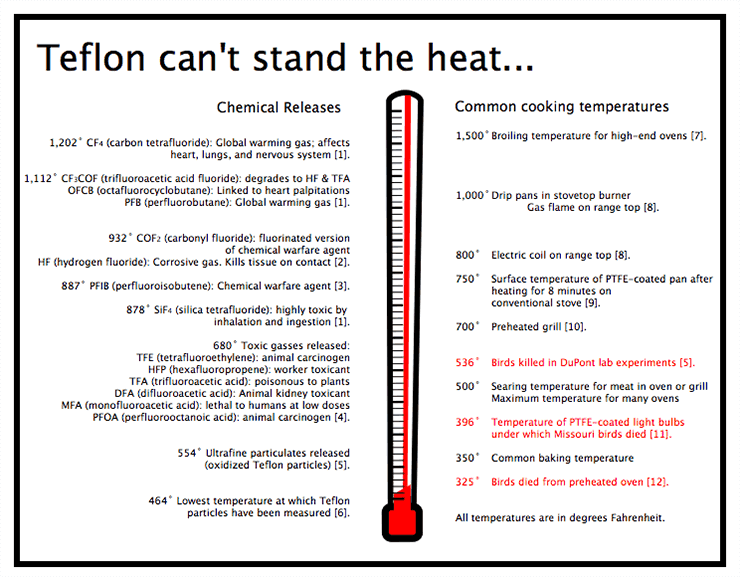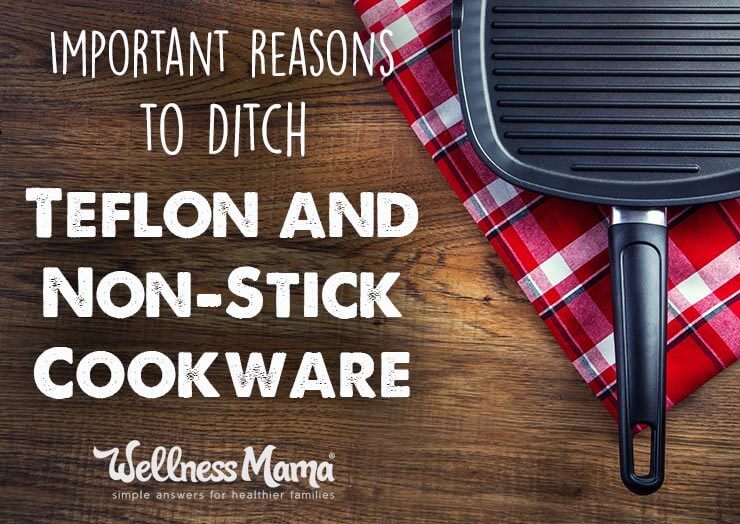Many of us own pots, pans, and bakeware that is covered in a non-stick coating. These products are not only inexpensive, but come with the promise of making our lives just a little bit easier. But have you ever wondered about the safety and health ramifications of these pans?
What Makes It Non-Stick?
Most non-stick cookware is aluminum coated with a synthetic polymer called polytetrafluoroethylene (PTFE). PTFE was developed by DuPont 1938, then patented and trademarked in 1945 as Teflon. (2, 7)
Teflon provides a non-stick surface because it is an extremely non-polar chemical, meaning that it repels other substances. Thus, it provides a frictionless surface and it also doesn’t react with other chemicals making it very stable. (4, 7)
Teflon is added to many products to make them resistant to water and stains. These include carpets, fabrics, clothing, and paint as well as cookware. (7)
Other brands that use PTFE include Silverstone, Stationmaster, and Gore-Tex. Teflon, and the chemicals used in its production have grown into an industry which profits $2 billion a year. (1, 6)
PTFE is a fluorotelomer, or a perflurorochemical (PFCs), and they received this name because they contain fluoride atoms. PFC’s have been shown to be carcinogenic, disrupt hormone balances and affect fetal development.
Since PFC’s have a variety of applications and the research on their effects is quite complex, I wrote a post discussing these chemicals in detail. For now, let’s turn our attention to Teflon.
The Trouble with Teflon
Despite the various pros of PTFE, there are also many cons. The main concern around Teflon is the fact that it produces fumes when overheated which has shown to kill pet birds and cause people to experience flu like symptoms.
The Teflon Flu
Polymer Fume Fever or the “Teflon Flu” refers to the flu-like symptoms of chills, sore throat, coughing, headaches, muscle aches, and fevers between 100-104°F, that a person may experience if they are exposed to the fumes released when non-stick cookware is overheated. Teflon flu generally lasts for two to three days. (6, 7)
While DuPont has known about the illness caused by its products, it claims that Teflon maintains its integrity until around 500°F, and only produces fumes when it reaches 660°F to 680°F. While that seems like a high number, studies have shown that not only is it easy to reach in conventional cooking, but that harmful compounds are released at lower temperatures. (2)
A study conducted in 1991 found that when Teflon cookware reached 464°F, PTFE particles could be measured in the air. At 554°F oxidized particles are released. At 680°F toxic gases are released which are known to be carcinogenic to animals, poisonous to plants, and even lethal to humans. (8)
Even within two to five minutes cookware on a conventional stove can reach these temperatures. An even greater concern is using Teflon under a broiler in the oven or on the grill. Many ovens today are made with non-stick materials, and have self-cleaning cycles which will reach 800°F. (1** 2)
While neither the long term effects of routine exposure, nor the effects of coming down with the “Teflon Flu” have been well studied, it does seem like there is minimal health risk in ingesting Teflon, even if it is flaking. (2)
There is, however, concern about exposure to PFOA, perfluorooctanoic acid, a PFC used to make PTFE. Even though its thought that there is minimal PFOA present in the final Teflon product, after repeated heating and cooling it’s possible for PFOA to leach into food.
Thankfully DuPont stopped using this PFC to manufacture Teflon in 2013. (7)
Canaries for Your Kitchen
While the chemical flu is the most studied effect on humans, there have been many reported avian fatalities. That’s right, pet birds are dying from pots and pans and muffin tins. (This also makes you wonder if there are longer-term damages that haven’t been identified yet!)
Some of These Documented Cases Include:
- Deaths of 1,000 broiler chicks under Teflon-coated heat lamps at 396°F
- Deaths of baby parrots (number unknown) when a Teflon lined oven was used to bake biscuits at 325°F
- Deaths of 55 birds when water burned off a hot pan.
- Death of pet Cockatoo when water was boiled out of a Teflon pan
The makers of Teflon even acknowledge this risk, and warn consumers about this issue. In an online brochure sponsored by DuPont, as well as the Association of Avian Veterinarians and the ASPCA, the writer (a veterinarian) states that “bird fatalities can result when both birds and cooking pots or pans are left unattended in the kitchen, even for a few minutes.” (7,10)

Of course, in this industry sponsored brochure, it is made to seem that any cookware can cause birds this harm. However, on its own website, the Association of Avian Veterinarians places only non-stick cookware under the category of air pollutants dangerous to pet birds.
Air pollutants such as cigarette smoke, insecticides, and toxic fumes from over-heated non-stick-coated utensils can cause serious respiratory problems and even death. (9)
All sources recommend that birds be kept out of the kitchen and that ventilation should be utilized when cooking with non-stick.
How to Avoid Teflon Fumes
Though cases of Teflon flu in humans are rare, they do occur. Also, some sources, like the EWG, have concerns about potential cancer links with teflon fumes, though more research is needed.
Of course, the best way to avoid Teflon fumes in the kitchen is to use alternative cookware. Stick with traditional cookware options such as stainless steel or cast iron pots and pans, and ceramic and glass bakeware.
In my experience its also best to avoid so called “green pans” which have a thin ceramic coating which scratches easily causing food to stick. A high quality alternative is fully ceramic pans or ceramic-enameled cast iron cookware like dutch ovens and brasiers.
My Cookware Choices
I wasn’t aware of the problems with Teflon when I got married, and while we registered for mostly stainless steel dishes, we did receive a few non-stick items as well. After researching, we eventually got rid of these pieces and I’ve actually downsized to just the few dishes that we use regularly and love. My personal favorite non-toxic cookware pieces are:
- A set of Xtrema Ceramic pans– I reviewed them in depth here, but I love them because they are metal free, teflon free, and non-scratch (making them very easy to clean!). They can also be stored in the fridge, used in the oven, on the stove, or even microwaved (though we don’t personally use them in the microwave).
- A Le Cruset Skillet– A tribute to my French side and a skillet I use often.
- Caraway – Made with naturally smooth ceramic and is free of PTFE & other toxic materials. This means no leaching and no harmful toxic fumes.
- From Our Place – Check out the Always Pan. This is one of my favorite pans to cook stir fry and veggies in. It comes with a stainless steel steamer tray and is a dream to cook with. And to clean!
- Stainless Steel Bakeware- See a full list of my kitchen supplies here and some unusual items I use daily in this post.
Can’t Ditch the Non-Stick Yet?
If you do have non-stick cookware and can’t (or don’t want to) get rid of it right now, there are many things you can do to limit your exposure to fumes such as:
- Never preheat non-stick cookware at high heat.
- Use low to medium cooking temperatures.
- Don’t put non-stick cookware in an oven heated to over 400°F.
- Use an exhaust fan when cooking with non-stick.
- Don’t use the self-cleaning function on your oven if it contains any non-stick coatings.
And of course, if you have pet birds… don’t keep them in the kitchen while you are cooking!
This article was medically reviewed by Madiha Saeed, MD, a board certified family physician. As always, this is not personal medical advice and we recommend that you talk with your doctor.
Do you use teflon? Ever considered trying other options?


Leave a Reply